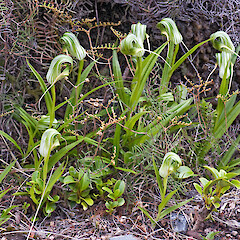Pterostylis patens
Common name
tutukiwi, greenhood
Synonyms
Pterostylis banksii var. patens (Colenso) Hatch, Pterostylis speciosa Colenso, Pterostylis subsimilis Colenso
Family
Orchidaceae
Flora category
Vascular – Native
Endemic taxon
Yes
Endemic genus
No
Endemic family
No
Structural class
Orchids
NVS code
The National Vegetation Survey (NVS) Databank is a physical archive and electronic databank containing records of over 94,000 vegetation survey plots - including data from over 19,000 permanent plots. NVS maintains a standard set of species code abbreviations that correspond to standard scientific plant names from the Ngä Tipu o Aotearoa - New Zealand Plants database.
PTEPAT
Chromosome number
2n = 44
Current conservation status
The conservation status of all known New Zealand vascular plant taxa at the rank of species and below were reassessed in 2017 using the New Zealand Threat Classification System (NZTCS) – more information about this can be found on the NZTCS website. This report includes a statistical summary and brief notes on changes since 2012 and replaces all previous NZTCS lists for vascular plants.
Please note, threat classifications are often suggested by authors when publications fall between NZTCS assessment periods – an interim threat classification status has not been assessed by the NZTCS panel.
- Conservation status of New Zealand indigenous vascular plants, 2017 . 2018. Peter J. de Lange, Jeremy R. Rolfe, John W. Barkla, Shannel P. Courtney, Paul D. Champion, Leon R. Perrie, Sarah M. Beadel, Kerry A. Ford, Ilse Breitwieser, Ines Schönberger, Rowan Hindmarsh-Walls, Peter B. Heenan and Kate Ladley. Department of Conservation. Source: NZTCS and licensed by DOC for reuse under the Creative Commons Attribution 4.0 International licence.
2017 | Not Threatened
Previous conservation statuses
2012 | Not Threatened
2009 | Not Threatened
2004 | Not Threatened
Distribution
Endemic. New Zealand: North Island (from about Mt Pirongia south), South Island, Stewart Island/Rakiura.
Habitat
Mostly montane to subalpine (up to 1200 m a.s.l.) but extending to lower elevations in the southern Wairarapa and Rimutaka Ranges. Frequenting beech (Nothofagaceae) forest but also found in montane cloud forest, and under subalpine scrub, usually in damp, semi-shaded sites. Often found in thick patches of moss or deep, drifts of leaf litter.
Detailed description
Terrestrial, tuberous, glabrous, spring to summer-green perennial herb, forming dense colonies of numerous plants through vegetative extension. Plant at flowering 100–480 mm tall. Stem stiffly erect, smooth, green, dark green to reddish green, internodes very short near base, otherwise shorter than leaves throughout. Leaves 4–6, sessile, stiffly erect, dark green to reddish green with entire margins; in sterile plants lamina of similar size, oblong-elliptic to broadly lanceolate; in flowering plants lamina scarcely changing from base to top of stem; lamina of largest leaves 50–180 × 10–20 mm, broadly lanceolate, lanceolate to linear-lanceolate, prominently and deeply keeled, often with 2–3 laterals on either side of midrib, apex acute, acuminate, base wider than rest of lamina broadening into a long sheathing base; more or less even within base of flower, rarely slightly overtopping flower. Flower solitary, erect, front mostly green finely striped with white, stripes of white widening toward back of galea with green narrowing, with the back often completely. Ovary erect. Dorsal sepal distinctly globose, 40–50 mm tall, erect, distal portion initially horizontal, soon steeply inclined, apex steeply keeled, tapering to a strongly deflexed caudate tip up to 30 mm long. Lateral sepals diverging at a narrow angle, caudae of lobes up to 40 mm long, tapered, strongly deflexed down and sometimes meeting behind ovary. Petals much shorter than dorsal sepal with acuminate apices. Labellum elliptic-oblong, scarcely arched, flat in cross-section, narrowing slightly towards tip, bending forwarding smoothly and symmetrical, protruding from lateral sepals sinus, midrib initially prominent soon evanescent toward the obtuse, emarginate, often cucullate apex. Column as tall as or slightly taller than labellum; stigma ellipsoid, scarcely distinguished from column and rather flat.
Manaaki Whenua Online Interactive Key
Similar taxa
Closest to P. oliveri Petrie, from which it differs by the stiffly erect rather than weakly erect, decumbent or sprawling growth habit, broadly lanceolate to linear-lanceolate (grassy) rather than oval to broadly elliptic leaves; and by the lateral sepals whose caudae are consistently strongly deflexed back and down, sometimes meeting at the back of the ovary, rather than mostly erect. Pterostylis patens was placed in Flora II of the New Zealand Flora series (Moore & Edgar 1970) within P. banksii. From that widespread and variable species it differs by the much larger, distinctly globose flower, by the greatly attenuated and strongly deflexed dorsal and lateral sepals, and by the mostly wider grassy leaves. Both species are frequently sympatric in the central North Island.
Flowering
November–January
Flower colours
Green, White
Fruiting
December–April
Propagation technique
Difficult—should not be removed from the wild. Basic orchid mix consists of 2 parts medium coarse sand, ideally clean river sand; 2 parts soil, humus or leaf-mould; 1 part weathered sawdust or rotting wood; 1 part granulated bark. For Pterostylis shade of 50% and pots kept evenly moist.
Etymology
pterostylis: Winged column
patens: Spreading
Where To Buy
Not commercially available
Attribution
Fact Sheet prepared for NZPCN by P.J. de Lange 14 April 2007: Description adapted from Moore and Edgar (1970) and Hatch (2005).
References and further reading
Moore LB, Edgar E. 1970. Flora of New Zealand, Volume II. Indigenous Tracheophyta: Monocotyledones except Gramineae. Government Printer, Wellington, NZ. 354 p.
St George I, Irwin B, Hatch D. 2005. Field guide to the New Zealand orchids, 3rd edition. New Zealand Native Orchid Group, Wellington, NZ. 136 p.
NZPCN Fact Sheet citation
Please cite as: de Lange, P.J. (Year at time of access): Pterostylis patens Fact Sheet (content continuously updated). New Zealand Plant Conservation Network. https://www.nzpcn.org.nz/flora/species/pterostylis-patens/ (Date website was queried)





